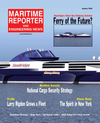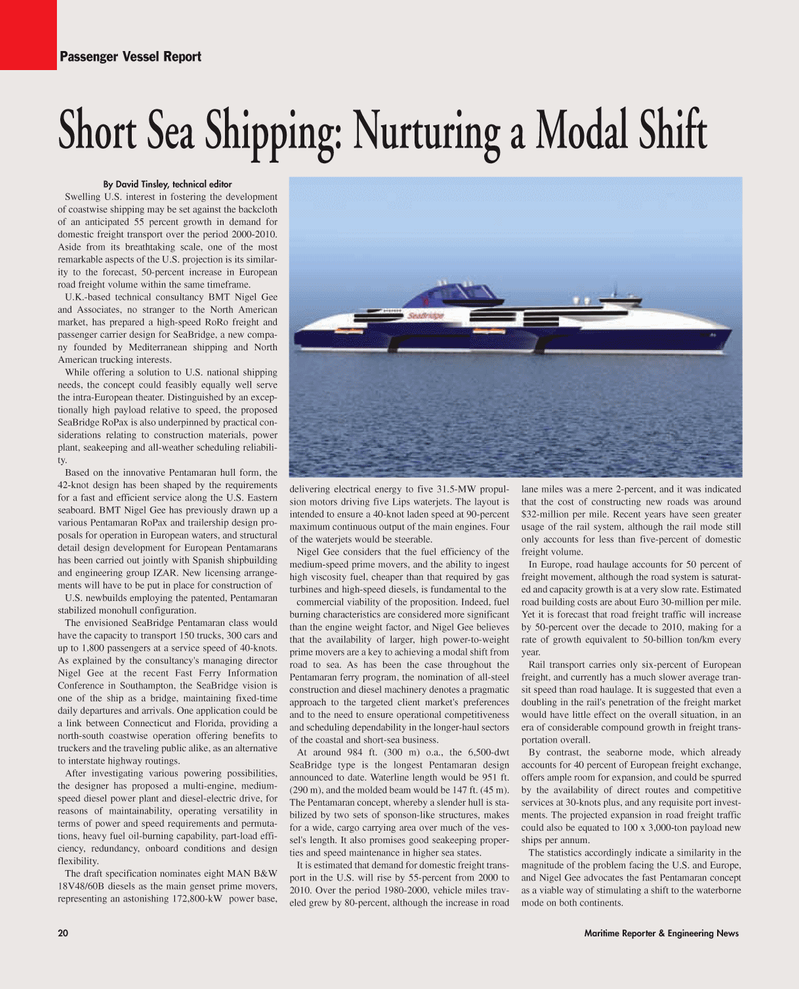
Page 20: of Maritime Reporter Magazine (January 2, 2005)
Read this page in Pdf, Flash or Html5 edition of January 2, 2005 Maritime Reporter Magazine
20 Maritime Reporter & Engineering News
Passenger Vessel Report
By David Tinsley, technical editor
Swelling U.S. interest in fostering the development of coastwise shipping may be set against the backcloth of an anticipated 55 percent growth in demand for domestic freight transport over the period 2000-2010.
Aside from its breathtaking scale, one of the most remarkable aspects of the U.S. projection is its similar- ity to the forecast, 50-percent increase in European road freight volume within the same timeframe.
U.K.-based technical consultancy BMT Nigel Gee and Associates, no stranger to the North American market, has prepared a high-speed RoRo freight and passenger carrier design for SeaBridge, a new compa- ny founded by Mediterranean shipping and North
American trucking interests.
While offering a solution to U.S. national shipping needs, the concept could feasibly equally well serve the intra-European theater. Distinguished by an excep- tionally high payload relative to speed, the proposed
SeaBridge RoPax is also underpinned by practical con- siderations relating to construction materials, power plant, seakeeping and all-weather scheduling reliabili- ty.
Based on the innovative Pentamaran hull form, the 42-knot design has been shaped by the requirements for a fast and efficient service along the U.S. Eastern seaboard. BMT Nigel Gee has previously drawn up a various Pentamaran RoPax and trailership design pro- posals for operation in European waters, and structural detail design development for European Pentamarans has been carried out jointly with Spanish shipbuilding and engineering group IZAR. New licensing arrange- ments will have to be put in place for construction of
U.S. newbuilds employing the patented, Pentamaran stabilized monohull configuration.
The envisioned SeaBridge Pentamaran class would have the capacity to transport 150 trucks, 300 cars and up to 1,800 passengers at a service speed of 40-knots.
As explained by the consultancy's managing director
Nigel Gee at the recent Fast Ferry Information
Conference in Southampton, the SeaBridge vision is one of the ship as a bridge, maintaining fixed-time daily departures and arrivals. One application could be a link between Connecticut and Florida, providing a north-south coastwise operation offering benefits to truckers and the traveling public alike, as an alternative to interstate highway routings.
After investigating various powering possibilities, the designer has proposed a multi-engine, medium- speed diesel power plant and diesel-electric drive, for reasons of maintainability, operating versatility in terms of power and speed requirements and permuta- tions, heavy fuel oil-burning capability, part-load effi- ciency, redundancy, onboard conditions and design flexibility.
The draft specification nominates eight MAN B&W 18V48/60B diesels as the main genset prime movers, representing an astonishing 172,800-kW power base, delivering electrical energy to five 31.5-MW propul- sion motors driving five Lips waterjets. The layout is intended to ensure a 40-knot laden speed at 90-percent maximum continuous output of the main engines. Four of the waterjets would be steerable.
Nigel Gee considers that the fuel efficiency of the medium-speed prime movers, and the ability to ingest high viscosity fuel, cheaper than that required by gas turbines and high-speed diesels, is fundamental to the commercial viability of the proposition. Indeed, fuel burning characteristics are considered more significant than the engine weight factor, and Nigel Gee believes that the availability of larger, high power-to-weight prime movers are a key to achieving a modal shift from road to sea. As has been the case throughout the
Pentamaran ferry program, the nomination of all-steel construction and diesel machinery denotes a pragmatic approach to the targeted client market's preferences and to the need to ensure operational competitiveness and scheduling dependability in the longer-haul sectors of the coastal and short-sea business.
At around 984 ft. (300 m) o.a., the 6,500-dwt
SeaBridge type is the longest Pentamaran design announced to date. Waterline length would be 951 ft. (290 m), and the molded beam would be 147 ft. (45 m).
The Pentamaran concept, whereby a slender hull is sta- bilized by two sets of sponson-like structures, makes for a wide, cargo carrying area over much of the ves- sel's length. It also promises good seakeeping proper- ties and speed maintenance in higher sea states.
It is estimated that demand for domestic freight trans- port in the U.S. will rise by 55-percent from 2000 to 2010. Over the period 1980-2000, vehicle miles trav- eled grew by 80-percent, although the increase in road lane miles was a mere 2-percent, and it was indicated that the cost of constructing new roads was around $32-million per mile. Recent years have seen greater usage of the rail system, although the rail mode still only accounts for less than five-percent of domestic freight volume.
In Europe, road haulage accounts for 50 percent of freight movement, although the road system is saturat- ed and capacity growth is at a very slow rate. Estimated road building costs are about Euro 30-million per mile.
Yet it is forecast that road freight traffic will increase by 50-percent over the decade to 2010, making for a rate of growth equivalent to 50-billion ton/km every year.
Rail transport carries only six-percent of European freight, and currently has a much slower average tran- sit speed than road haulage. It is suggested that even a doubling in the rail's penetration of the freight market would have little effect on the overall situation, in an era of considerable compound growth in freight trans- portation overall.
By contrast, the seaborne mode, which already accounts for 40 percent of European freight exchange, offers ample room for expansion, and could be spurred by the availability of direct routes and competitive services at 30-knots plus, and any requisite port invest- ments. The projected expansion in road freight traffic could also be equated to 100 x 3,000-ton payload new ships per annum.
The statistics accordingly indicate a similarity in the magnitude of the problem facing the U.S. and Europe, and Nigel Gee advocates the fast Pentamaran concept as a viable way of stimulating a shift to the waterborne mode on both continents.
Short Sea Shipping: Nurturing a Modal Shift
MR JANUARY 2005 #3 (17-24).qxd 1/5/2005 2:52 PM Page 4

 19
19

 21
21
